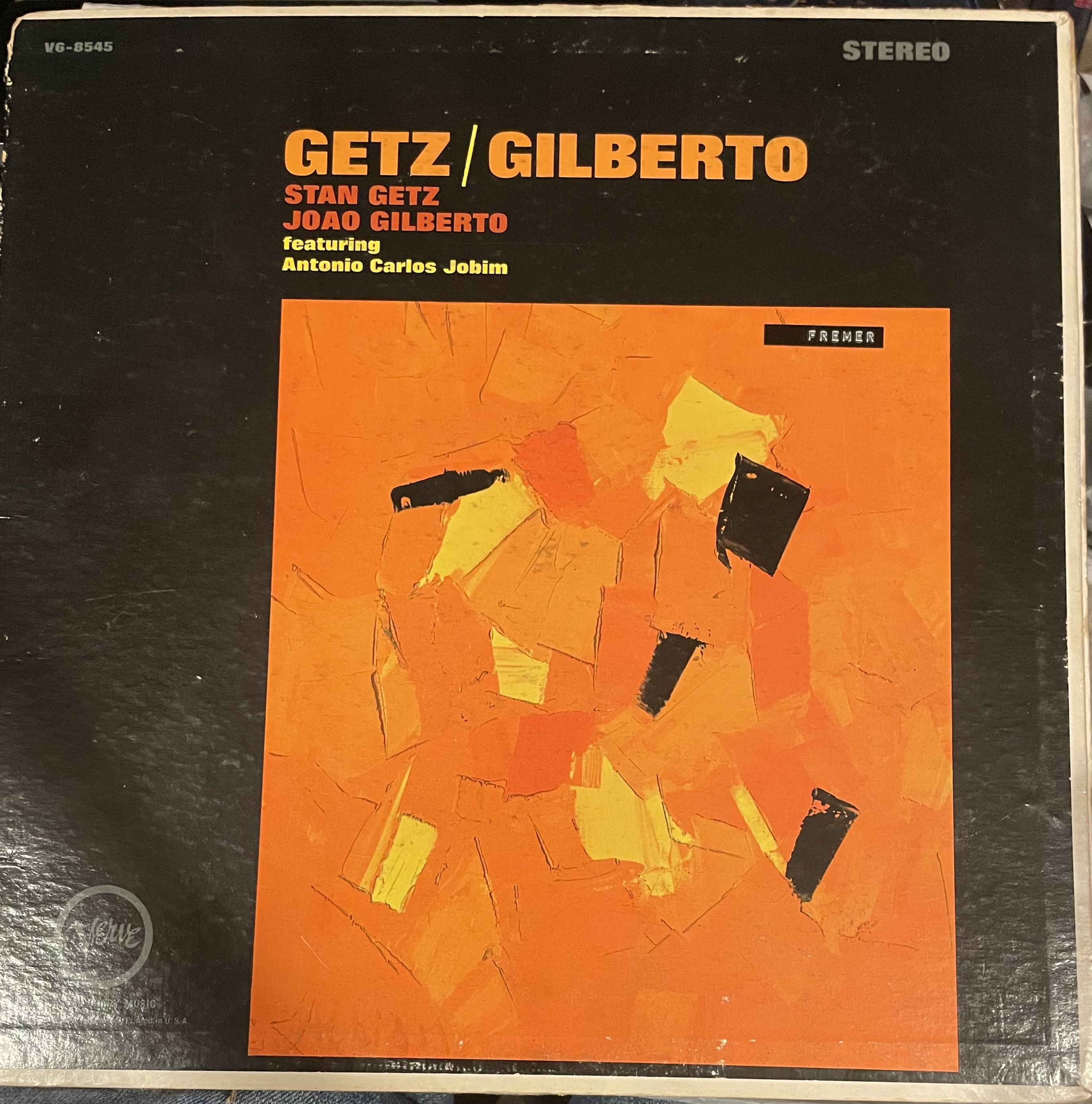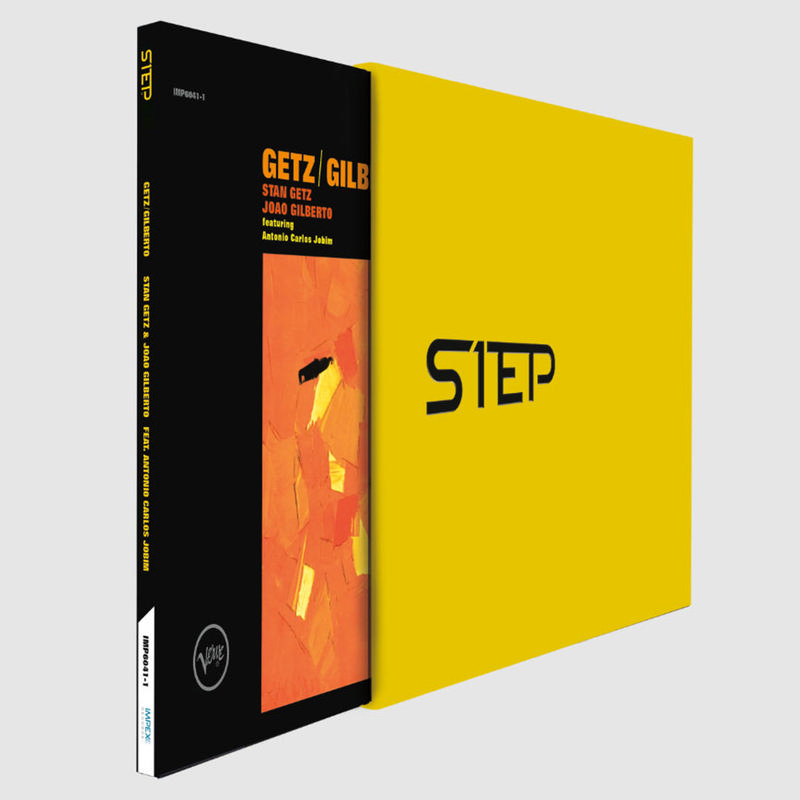Impex's 1Step Double 45 "Getz/Gilberto" Tells The Full Story Sonically And Otherwise
a treasure trove of background information adds luster to a familiar record
Have you seen the 2022 movie “Armaggedon Time”? It’s a coming of age movie set in 1980 Queens, New York about a creative, dreamer of a young man who wants to become an artist but his traditional Jewish parents are of course against it, preferring he become a “professional”. His musical tastes are rock’n’roll but after befriending a Black classmate, he’s introduced to Hip-Hop.
Not that the movie is about music, but music represents the cultural crosswind at the time in which the kid finds himself. The set designer, or perhaps the director James Gray himself, puts a record player and a collection of records in the living room. The record visible at the end of the shelf is Getz/Gilberto. It represents, I suppose, “safe” music for the parents, or perhaps their “jazz experiment”, which it became at that time for so many adults. The Clash was the kid’s music (as it was for the director) with the band’s cover of “Armagideon Time” serving as the inspiration for the movie title.
The only record more likely to be found in suburban households at that time, was Vaughn Meader’s 1962 comedy smash The First Family, which a year later was either tossed or put on the shelf as far back as possible, never again to be played.
Both records set records and here we are sixty years after Getz/Gilberto was first released, with yet another reissue of an album that’s been reissued domestically more than forty times, and according to Discogs, hundreds of times worldwide. Someone there is selling for $1,999.99 an original 7 ½ IPS commercial tape.
Of them all—and there are many good ones—this one is clearly the most deluxe, well-researched, well-presented and most meticulously pressed "1Step" onto 180g Neotech VR900-Supreme semi-transparent vinyl. Bernie Grundman “mastered from the original analog master tape”.
Side four includes two bonus tracks taken from tapes and spliced on following “O Grande Amor” and “Vivo Shoando”. One is a monophonic single of “The Girl From Ipanema” that’s minus Getz’s solo and the second is a real treat: a stereo Carnegie Hall performance recording of “Corcovado”.
With the $129.98 release limited to 7500 numbered copies a new lacquer and stamper must be produced every 500 copies. Therefore, skeptics would note, Bernie would have to cut fifteen lacquers and the tape run fifteen times. And the tape would have to remain at Bernie’s the whole time. That’s impossible!
Yet, that’s exactly how it’s being produced!
Within a sturdy, pebbly-yellow slipcase resides a “Monster Pak” Stoughton Press laminated gatefold jacket in the center of which is a most wonderous thirty page full sized, glossy color booklet that reveals, for those who are interested, much of the album’s background, recording, including the microphones used, how they were placed, even the composition of the A&R Studios floor and how the first pressing of the album was sourced from the original three-track master tape and not from the later two track mixdown tape used for all subsequent pressings.
The booklet includes the original annotation plus Charles L. Granata’s illuminating essay “Creating Thirty Five Minutes of Musical Bliss” which describes how at the urging of his wife Monica, Stan Getz got involved with Jõao Gilberto and Antonio Carlos Jobim, who recommended the other Brazilian musicians who play on the record.
Phil Ramone (real name: Phil Rabinowitz) (1934-2013)—as we all know, one of the greatest recording engineers ever—recalls how hearing the rehearsals “live” when he went into the relatively small studio to adjust the microphones made the hair on the back of his neck stand up. No isolation booths were used, nor did the musicians wear headphones. Both choices produced plenty of microphone leakage, which helped create the warm, cozy feel of the recording. It also made Getz’s saxophone loud and prominent in the minimalist mix. It also helped to capture Getz’s tone as well if not better than it had previously sounded on record.
 Phil Ramone at the Winter Consumer Electronics Show, 2005
Phil Ramone at the Winter Consumer Electronics Show, 2005
The booklet is filled with great previously unpublished photos and an essay by Getz’s Swedish wife Monica that’s both interesting and useful in fully understanding how the record came to be. She doesn’t spare some of the details of Getz’s personal difficulties and describes how the determined jazz great pursued, courted and won her heart. It’s a great story.
In his liner notes for Getz’s 1956 release Stan Getz in Stockholm (Verve MGV8213), Nat Hentoff wrote of Getz (real name Stanley Gayetski, paternal grandparents from Kyiv, Ukraine), almost in the past tense as if he wasn’t longed for the world (he’d been in a Stockholm hospital for four months shortly before the recording) “It is difficult to predict his future. It may be he will never leave much if any written frameworks for others to explore themselves in, but he will certainly have left the effects of an undeniably personal voice.” (Getz succumbed to liver cancer in 1991 at age 64).

Seven short years later he recorded Getz/Gilberto, which is among the all-time best-selling jazz albums with more than a million copies sold (it peaked at #2 on the Billboard charts on August 8th, 1964 and remained on the charts for ninety six weeks) and one with a remarkably enduring legacy as generation after generation of listeners discover its easy charms and (despite some tape flaws) its sonic magic.
If you’re tasked with listening and comparing seven versions of an album you couldn’t ask for a better record than Getz/Gilberto. The music and sound are to luxuriate in, and the feeling doesn’t diminish after multiple plays. Hell, I’ve been playing it since it was first released March, 1964. The recording at Phil Ramone’s A&R Studios commenced the previous March. The release was delayed a year supposedly because producer Creed Taylor feared it would be a commercial failure. Sixty one years later we all know how that turned out.
The various released versions throughout the decades, place Astrud Gilberto’s voice sometimes in the right channel and sometimes in the left (with everything else of course also reversed). With most of those involved in the production now deceased, which is correct, remains unclear.
An absolute original pressing supervised by Ramone and cut from the three-track tape would be dispositive but no one involved in this reissue or any of the others can seem to find one!
My very early pressing bought in the spring of 1964, (which features a white jacket surround), has on side one a RE-1 inscribed in the lead out groove area following 63-VGS-560. What the revision was, and whether it was the three track cut, I don’t know. It also has “F.G.” inscribed above the numbers. I can’t find any information about a mastering engineer with initials F.G.

The versions I listened to are:
1) The very early (RE-1) with Astrid singing in the right channel.
2) Mobile Fidelity’s 1994 Anadisc 200 version ½ speed mastered by Ken Lee (right channel)
3) The Speakers Corner 1999 Kevin Gray cut (left channel).
4) Analogue Productions’ 2011 double 45 cut by George Marino at Sterling Sound (left channel)
5) Analogue Productions 2020 33 1/3 George Marino 2011 cut (left channel)
6) Supersense 2022 acetate (left channel)
7) Impex’s new 1Step double 45 (right channel).
And here’s your turn to hear thirty second “fair use” high resolution snippets from each of the seven that I auditioned. Feel free to comment and guess which is which! Just remember, as with loudspeaker comparison box switching, your ear will gravitate to the loudest and brightest so be careful! All of them effectively deliver Getz's feathery, lush tenor sax IMO, though there are differences, and which you prefer may depend as much upon your system as your sonic preferences).
Seven thirty second "fair use" snippets"
In a note included in the jacket Impex says it chose to “not correct the reversed channels”, which means Astrud sings from the right channel on its release. And it points out something you’ll hear (if you haven’t already on other versions) which are a few master tape sonic flaws including tape drop out during Getz’s first solo on “The Girl From Ipanema” and bass distortion on “Corcovado”. Impex chose to not attempt a fix, analog, or digital, in order to preserve the original’s sonic integrity (the bass distortion issue isn’t major in my opinion).
The original pressing does not have the Getz solo dropout. Nor for some reason does the Supersense lacquer (I’ve not had a chance to ask Supersense’s Florian “Doc” Caps about this).
Until this Impex 1Step, my two faves were the original, which in some ways still can’t be beat, and the double 45 Analogue Productions edition cut by George Marino. The original of course has the advantage of being cut when the tape was fresh, and for all I know, mine was cut directly from the three-track tape. It’s swell! The AP double 45 is also outstanding, but this new 1Step delivers greater detail, particularly in terms of transient attack precision and the Neotech VR900-Supreme produces drop dead quiet and timbral serenity. This formulation isn't ideal for every recording and/or musical genre, but it perfectly suits this one.
The Impex folks did their best to produce the best sounding Getz/Gilberto yet, and if you’re used to other versions, I’m sure you’ll hear the blackest backgrounds and Milton Banana’s percussion has never sounded so appealing (sorry I couldn’t help myself). Seriously, you’ve never heard his percussive accents presented with this kind of clarity and microdynamic attack subtlety—and that matters for this music and for this recording.
Whether or not you want to spend the $129.98 to own what surely delivers the most complete story and the most highly evolved sound that will ever be wrung from the sixty year old tapes (plus the two bonus tracks) is your choice. This production will take you closer to both the music and the tape's flaws. It's a document, not an attempted cover up. If you love the record, you'll probably cherish the purchase and love both the read and the listen.
As far as I'm concerned, Impex has delivered one of the most impressive reissue packages in the history of "the vinyl revival" era. You'll appreciate the care that went into it as you listen, turn the pages, read the story and view the heretofore unpublished photos. You'll surely come away with a new appreciation for Getz/Gilberto.












































.png)








